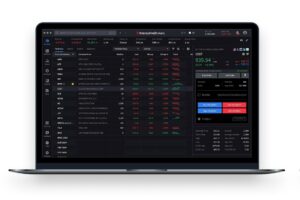On Thursday, US stocks rose as investors evaluated fresh labor market data and increased bets on a Federal Reserve interest rate cut later this month. The Dow Jones (US30) climbed 0.77%, the S&P 500 (US500) gained 0.83%, and the Nasdaq (US100) was up 0.98%. New data showed that private sector jobs in August increased by only 54,000, which was significantly below expectations. Additionally, jobless claims rose to their highest level since June, signaling a cooling labor market. Traders interpreted this slowdown as a catalyst for a September rate cut, with federal fund futures pricing in a more than 95% chance of a reduction.
Corporate earnings also influenced market momentum. Amazon shares jumped 4.3% on optimism about the company’s AI connections, Meta added 1.6%, and Broadcom rose by 1.2% ahead of its results. However, Salesforce dropped 5.1% following a weak prognosis.
The Mexican peso (MXN) weakened to around 18.75 per US dollar, a two-week low, due to a stronger US dollar and weaker domestic flows. The outlook on Banxico’s (Mexico’s Central Bank) policy appears increasingly gradual. Unemployment rose to 2.8% in July from 2.7% in June, a moderate increase that is cooling consumption and strengthening the case for further monetary easing. The Central Bank started a moderate easing cycle by cutting its rate by 25 basis points to 7.75%, signaling a slow, data-dependent path for reductions, which lessens the appeal of interest-rate carry trades.
European stock markets were mostly higher on Thursday, with the German DAX (DE40) up 0.74%, the Spanish IBEX35 (ES35) gaining 0.87%, and the UK FTSE 100 (UK100) closing 0.42% higher. The French CAC 40 (FR40), however, closed down 0.27%. European equities closed with solid gains on a drop in long-term bond yields and easing concerns about rising borrowing costs.
WTI crude oil prices fell to $63.5 per barrel on Thursday, extending a 2.5% drop from the previous session. Supply concerns were heightened by an unexpected increase in US inventories. US commercial crude oil stocks rose by 2.4 million barrels in the week ending August 29, significantly exceeding expectations. This signals slowing current demand and inflated stockpiles, confirming data from the API (American Petroleum Institute). Meanwhile, OPEC+ is poised to increase production further, with talks underway for additional cuts to output and increased supply in October, which would exacerbate an already saturated market.
Asian markets were mostly down yesterday. The Japanese Nikkei 225 (JP225) rose by 1.53%, while the Chinese FTSE China A50 (CHA50) fell by 1.24%, and the Hong Kong Hang Seng (HK50) dropped 1.12%. The Australian ASX 200 (AU200) posted a positive result, up 1.00%.
Japan: According to an executive order signed by President Donald Trump on Thursday, the United States will cut tariffs on imported Japanese automobiles to 15% by the end of the month. This move formalizes a trade agreement between Washington and Tokyo announced in July, easing months of negotiations and reducing uncertainty for the Japanese automotive sector. The 15% cap will also apply to most other Japanese imports under the agreement. The deal also confirms Japan’s commitment to invest $550 billion in US projects. The tariff cuts will take effect seven days after the order is published, with some benefits retroactive to August 7.
Australia: Strong economic data this week led investors to lower expectations for further RBA (Reserve Bank of Australia) policy easing. Markets are now pricing in an 80% chance of a 0.25% rate cut in November, down from 100% at the start of the week. Economists note that rising household consumption and improving sentiment are supporting the Australian dollar, while robust consumer spending and a stable labor market could limit further rate cuts.
New Zealand: Expectations of further monetary policy easing by the RBNZ (Reserve Bank of New Zealand) continued to cap the New Zealand dollar’s rise. Markets are pricing in a rate cut at the Central Bank’s next meeting in October, with rates projected to fall to around 2.50% by early next year. The currency has been on the defensive since the RBNZ lowered its official cash rate to 3.0% last month and signaled that further cuts may be needed to stimulate a sluggish economy.









